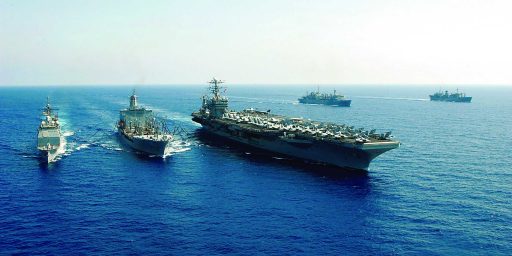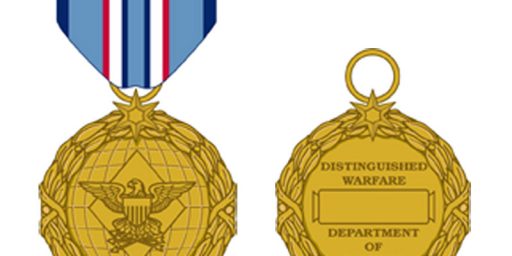Admiral Eugene Fluckey, Medal of Honor and Four Time Navy Cross Recipient, RIP
The word “hero” is getting attached to many things since 2001. Sometimes it isn’t just doing something as an individual, it is being the one making the decisions affecting the lives of 50 or 100 men, as well as oneself. That is what true leadership is.
Rear Adm. Eugene B. Fluckey, one of the greatest naval heroes of World War II who was awarded the Medal of Honor and four Navy Crosses for his daring submarine attacks on Japanese shipping, died June 28 at Anne Arundel Medical Center. He was 93 and had Alzheimer’s disease.
Adm. Fluckey, who was born and raised in Washington, was a pioneer of submarine warfare and among the most highly decorated veterans from any branch of the military.
[…]
On Jan. 25, 1945, Adm. Fluckey embarked on what Navy officials, seldom given to hyperbole, called “virtually a suicide mission — a naval epic.” In “an exceptional feat of brilliant deduction and bold tracking,” in the words of his Medal of Honor citation, Adm. Fluckey found more than 30 Japanese vessels lurking in a concealed harbor protected by mines and rocky shoals.
Evading a cordon of armed escort boats, the Barb slipped into the harbor on a moonless, cloudy night and scored eight direct torpedo hits on six large ships. One of them was an ammunition vessel, which exploded and caused “inestimable damage by the resultant flying shells and other pyrotechnics,” according to the Medal of Honor citation.As Adm. Fluckey watched from the bridge of his submarine, The Washington Post reported in 1945, “Japanese ships were erupting in the night like a nest of volcanoes.” The Barb then fled at high speed “through uncharted rocky waters thick with fishing junks,” pursued by two Japanese gunboats. Because of the shallow water, the submarine had to stay on the surface, dodging obstacles and steady fire for a full hour before reaching the safe depths of the open sea.
“The significance of that mission,” said retired Navy Capt. Max Duncan, who was the chief gunnery and torpedo officer of the Barb, “was that we completely disrupted the entire shipping system the Japanese had developed at that point in the war. […] Adm. Fluckey and his 80-man crew were credited with sinking 29 ships, including an aircraft carrier, destroyer and cruiser. He destroyed more gross tonnage than any other submarine commander. For his wartime exploits, he became known as “Lucky Fluckey” and the “Galloping Ghost of the China Coast.”
Adm. Fluckey sometimes violated Navy regulations by stashing cases of beer in the officers’ shower. Whenever the Barb sank a ship, everyone on board was entitled to a cold beer, which endeared him to his crew.
In addition to the Medal of Honor and Navy Crosses (second only to the Medal of Honor), Adm. Fluckey received the Distinguished Service Medal, the Legion of Merit and a host of lesser decorations. His greatest achievement, he often said, was that no one under his command ever received another well-known medal: the Purple Heart.
Wikipedia has more on this hero:
As commanding officer of Barb, he established himself as one of the greatest submarine skippers, credited with the most tonnage sunk by a U.S. skipper during World War II: 17 ships including a carrier, cruiser, and frigate. In one of the stranger incidents in the war, Fluckey sent a landing party ashore to set demolition charges on a coastal railway line, which destroyed a 16-car train.[2] This was the sole landing by U.S. military forces on the Japanese home islands during World War II.
Fluckey ordered that this landing party be comprised of crewmen from every division on his submarine and asked for as many ex-Boy Scouts as possible because Fluckey knew they would know how to find their way in unfamiliar territory.
Fluckey received four Navy Cross Medals for extraordinary heroism during the eighth, ninth, tenth, and twelfth war patrols of Barb. During his famous eleventh patrol, he continued to revolutionize submarine warfare, inventing the night convoy attack from astern by joining the flank escort line. He attacked two convoys at anchor 26 miles inside the 20 fathom (37 m) curve on the China coast, totaling more than 30 ships. With two frigates pursuing, Barb set a then-world speed record for a submarine of 23.5 knots (44 km/h) using 150% overload. For his conspicuous gallantry and intrepidity, Fluckey received the Medal of Honor. Barb received the Presidential Unit Citation for the eighth—eleventh patrols and the Navy Unit Commendation for the twelfth patrol.
His book, Thunder Below! (1992), depicts the exploits of his beloved Barb.”Though the tally shows more shells, bombs, and depth charges fired at BARB, no one received the Purple Heart and Barb came back alive, eager, and ready to fight again.
The Submarine Force, a very small portion of the Navy, has been awaiting this death for a year.
Is there a Washington DC Memorial to local Medal of Honor awardees? If not, there should be, and Gene Fluckey should be the impetus for such a local monument.
And after retirement, he “ran an orphanage with his second wife in Portugal for a number of years.”
The Submarine Blogs such as The Stupid Shall Be Punished, and the Rotini BBS (yes, an old style BBS still exists) have more from the Submarine Force view.
The Citation:
For conspicuous gallantry and intrepidity at the risk of his life above and beyond the call of duty as commanding officer of the U.S.S. Barb during her 11th war patrol along the east coast of China from 19 December 1944 to 15 February 1945. After sinking a large enemy ammunition ship and damaging additional tonnage during a running 2-hour night battle on 8 January, Comdr. Fluckey, in an exceptional feat of brilliant deduction and bold tracking on 25 January, located a concentration of more than 30 enemy ships in the lower reaches of Nankuan Chiang (Mamkwan Harbor). Fully aware that a safe retirement would necessitate an hour’s run at full speed through the uncharted, mined, and rock-obstructed waters, he bravely ordered, “Battle station—torpedoes!” In a daring penetration of the heavy enemy screen, and riding in 5 fathoms [9 m] of water, he launched the Barb’s last forward torpedoes at 3,000 yard [2.7 km] range. Quickly bringing the ship’s stern tubes to bear, he turned loose 4 more torpedoes into the enemy, obtaining 8 direct hits on 6 of the main targets to explode a large ammunition ship and cause inestimable damage by the resultant flying shells and other pyrotechnics. Clearing the treacherous area at high speed, he brought the Barb through to safety and 4 days later sank a large Japanese freighter to complete a record of heroic combat achievement, reflecting the highest credit upon Comdr. Fluckey, his gallant officers and men, and the U.S. Naval Service.
Fair winds and following seas Admiral.






An inspiring man and a true hero. Godspeed Admiral Fluckey.
Beautifully written post about an inspiring man.
The MOH Society just reopened its renovated Museum in Mt. Pleasant (Charleston), SC at Patriots Point Maritime Museum. I think they moved it there from the Intrepid sometime in the late 80s-early 90s.
I had the privilege of seeing Stockdale and Fluckey at a question/answer forum at Annapolis around 1988. Their demeanors were almost complete opposites. Stockdale came across as serious and proud of his Naval Academy heritage. Fluckey was humorous and downplayed his Naval Academy heritage (I can easily see him hiding beer in the shower). Both are/were true heroes in my book.